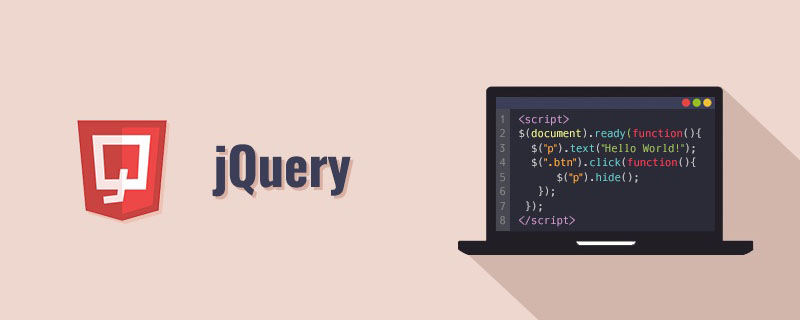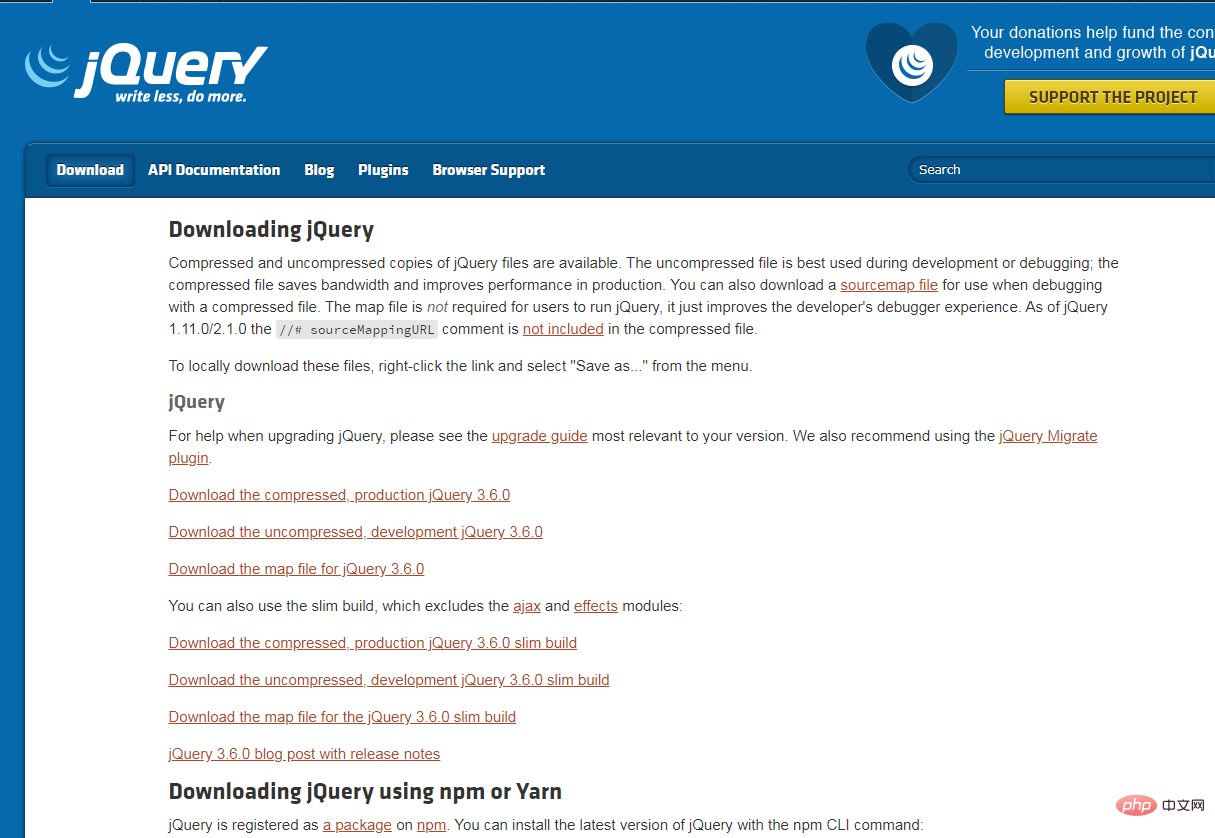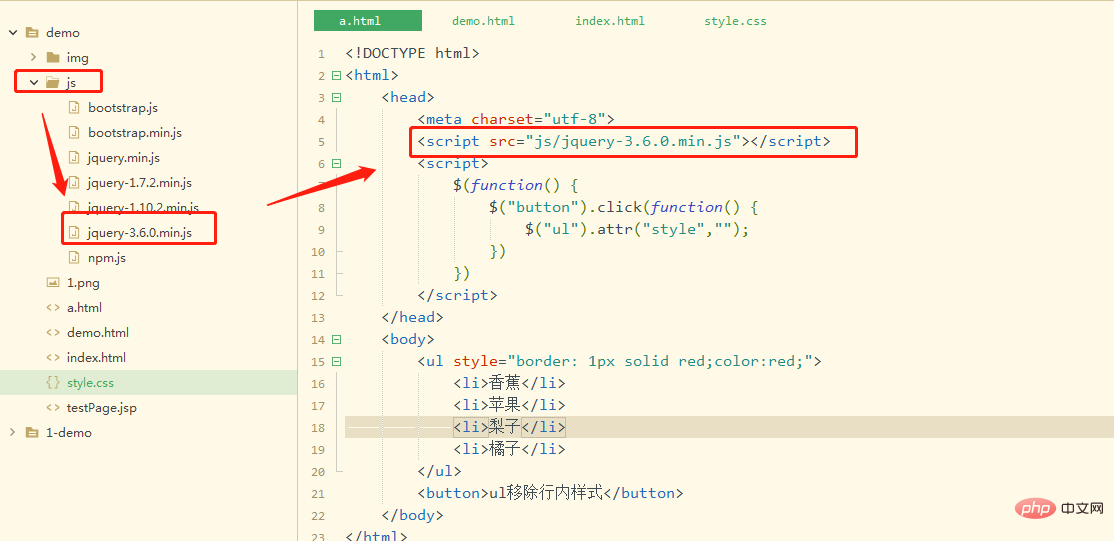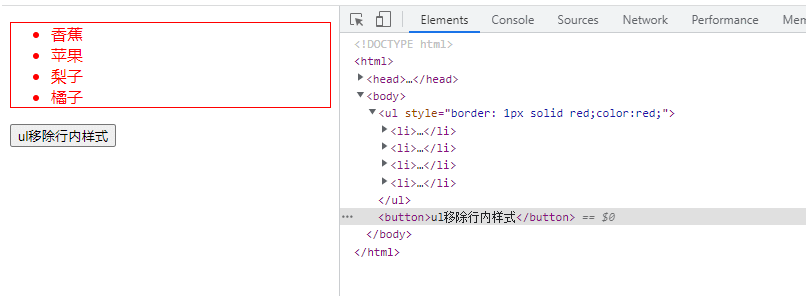Do I need to import it before using jquery?
You need to import it before using jquery. Two import methods: 1. Download the jquery file locally from the jquery official website, and use the script tag in the HTML document to import the local jquery file. The syntax is ""; 2. Use the script tag in HTML to import the online jquery file, with the syntax "".

The operating environment of this tutorial: windows7 system, jquery3.6.0 version, Dell G3 computer.
jquery is a library used to quickly write front-end scripting language instead of JavaScript. jquery can greatly simplify complex js code, allowing developers to focus on achieving the effect of the page.
Before using jquery, it needs to be imported into the HTML document. There are two ways to import jquery, one is local import and the other is import from hyperlink.
Method 1: Local import
We can search jquery on Baidu and find the official website of jquery: https://jquery.com /
You can download the latest version of jquery from here. Click the download icon and you will jump to the download details page:

The first two links here There are two versions of jquery to download, one is a compressed version and the other is an uncompressed version. There is no functional difference between the two versions. It is just that the compressed version takes up less space for jquery when publishing the project. For the compressed version jquery deletes redundant spaces and line breaks to achieve the purpose of simplification. As developers, we have not yet reached the stage of publishing the project, so we just choose the second uncompressed version (uncompressed).
Click on the link and you can see the source code of jquery. We directly ctrl a, select all, create a new txt file, copy the source code into it, and then change the suffix to .js.
Next, we introduce this .js file into the page where we want to use jquery. The code is as follows:
<script></script> <script> //在此书写你的jquery代码 </script>


Attention please! Be sure to write the imported script first and then your own jquery code. Because the loading order of the page is from top to bottom, the browser will load your jquery code first and then the jquery library, causing your jquery code to be considered an error. The writing format cannot achieve the effect.
Method 2: Import online jqueryWe can import online jquery code by writing a URL in the src attribute of script. Someone You may want to ask, wouldn't this cause a time to download jquery when the web page is loaded? Will it take a long time to download, causing your jquery code to never be loaded, affecting the user experience?
In fact, there are many websites that use jquery now. The browser will pre-download jquery when loading the website that used jquery before, so we don’t need to download it again, even if our jquery version is It is a new version that has not been loaded by the browser, and the jquery code will be downloaded very quickly. However, if you are still worried about affecting the loading speed, importing the jquery file locally is indeed the best way. For example, the online JQ file of jquery official website: https://code.jquery.com/jquery-3.6.0.min.jsImport online jquery: 
<script></script> <script> //在此书写你的jquery代码 </script>
jQuery video tutorial
,web front-end video]
The above is the detailed content of Do I need to import it before using jquery?. For more information, please follow other related articles on the PHP Chinese website!

Hot AI Tools

Undresser.AI Undress
AI-powered app for creating realistic nude photos

AI Clothes Remover
Online AI tool for removing clothes from photos.

Undress AI Tool
Undress images for free

Clothoff.io
AI clothes remover

AI Hentai Generator
Generate AI Hentai for free.

Hot Article

Hot Tools

Notepad++7.3.1
Easy-to-use and free code editor

SublimeText3 Chinese version
Chinese version, very easy to use

Zend Studio 13.0.1
Powerful PHP integrated development environment

Dreamweaver CS6
Visual web development tools

SublimeText3 Mac version
God-level code editing software (SublimeText3)

Hot Topics
 1386
1386
 52
52
 Detailed explanation of jQuery reference methods: Quick start guide
Feb 27, 2024 pm 06:45 PM
Detailed explanation of jQuery reference methods: Quick start guide
Feb 27, 2024 pm 06:45 PM
Detailed explanation of jQuery reference method: Quick start guide jQuery is a popular JavaScript library that is widely used in website development. It simplifies JavaScript programming and provides developers with rich functions and features. This article will introduce jQuery's reference method in detail and provide specific code examples to help readers get started quickly. Introducing jQuery First, we need to introduce the jQuery library into the HTML file. It can be introduced through a CDN link or downloaded
 How to use PUT request method in jQuery?
Feb 28, 2024 pm 03:12 PM
How to use PUT request method in jQuery?
Feb 28, 2024 pm 03:12 PM
How to use PUT request method in jQuery? In jQuery, the method of sending a PUT request is similar to sending other types of requests, but you need to pay attention to some details and parameter settings. PUT requests are typically used to update resources, such as updating data in a database or updating files on the server. The following is a specific code example using the PUT request method in jQuery. First, make sure you include the jQuery library file, then you can send a PUT request via: $.ajax({u
 In-depth analysis: jQuery's advantages and disadvantages
Feb 27, 2024 pm 05:18 PM
In-depth analysis: jQuery's advantages and disadvantages
Feb 27, 2024 pm 05:18 PM
jQuery is a fast, small, feature-rich JavaScript library widely used in front-end development. Since its release in 2006, jQuery has become one of the tools of choice for many developers, but in practical applications, it also has some advantages and disadvantages. This article will deeply analyze the advantages and disadvantages of jQuery and illustrate it with specific code examples. Advantages: 1. Concise syntax jQuery's syntax design is concise and clear, which can greatly improve the readability and writing efficiency of the code. for example,
 How to remove the height attribute of an element with jQuery?
Feb 28, 2024 am 08:39 AM
How to remove the height attribute of an element with jQuery?
Feb 28, 2024 am 08:39 AM
How to remove the height attribute of an element with jQuery? In front-end development, we often encounter the need to manipulate the height attributes of elements. Sometimes, we may need to dynamically change the height of an element, and sometimes we need to remove the height attribute of an element. This article will introduce how to use jQuery to remove the height attribute of an element and provide specific code examples. Before using jQuery to operate the height attribute, we first need to understand the height attribute in CSS. The height attribute is used to set the height of an element
 jQuery Tips: Quickly modify the text of all a tags on the page
Feb 28, 2024 pm 09:06 PM
jQuery Tips: Quickly modify the text of all a tags on the page
Feb 28, 2024 pm 09:06 PM
Title: jQuery Tips: Quickly modify the text of all a tags on the page In web development, we often need to modify and operate elements on the page. When using jQuery, sometimes you need to modify the text content of all a tags in the page at once, which can save time and energy. The following will introduce how to use jQuery to quickly modify the text of all a tags on the page, and give specific code examples. First, we need to introduce the jQuery library file and ensure that the following code is introduced into the page: <
 Use jQuery to modify the text content of all a tags
Feb 28, 2024 pm 05:42 PM
Use jQuery to modify the text content of all a tags
Feb 28, 2024 pm 05:42 PM
Title: Use jQuery to modify the text content of all a tags. jQuery is a popular JavaScript library that is widely used to handle DOM operations. In web development, we often encounter the need to modify the text content of the link tag (a tag) on the page. This article will explain how to use jQuery to achieve this goal, and provide specific code examples. First, we need to introduce the jQuery library into the page. Add the following code in the HTML file:
 How to tell if a jQuery element has a specific attribute?
Feb 29, 2024 am 09:03 AM
How to tell if a jQuery element has a specific attribute?
Feb 29, 2024 am 09:03 AM
How to tell if a jQuery element has a specific attribute? When using jQuery to operate DOM elements, you often encounter situations where you need to determine whether an element has a specific attribute. In this case, we can easily implement this function with the help of the methods provided by jQuery. The following will introduce two commonly used methods to determine whether a jQuery element has specific attributes, and attach specific code examples. Method 1: Use the attr() method and typeof operator // to determine whether the element has a specific attribute
 Understand the role and application scenarios of eq in jQuery
Feb 28, 2024 pm 01:15 PM
Understand the role and application scenarios of eq in jQuery
Feb 28, 2024 pm 01:15 PM
jQuery is a popular JavaScript library that is widely used to handle DOM manipulation and event handling in web pages. In jQuery, the eq() method is used to select elements at a specified index position. The specific usage and application scenarios are as follows. In jQuery, the eq() method selects the element at a specified index position. Index positions start counting from 0, i.e. the index of the first element is 0, the index of the second element is 1, and so on. The syntax of the eq() method is as follows: $("s




